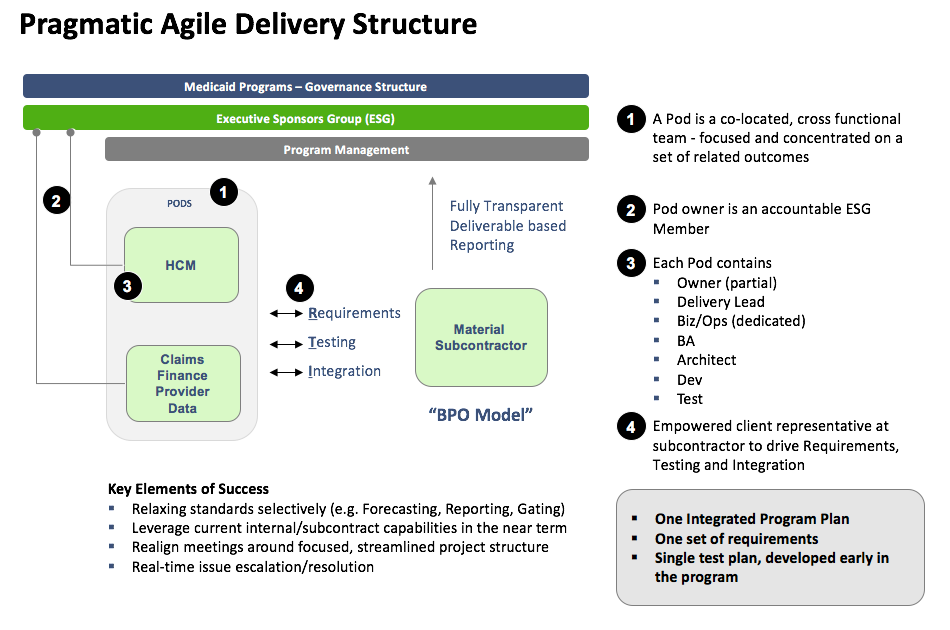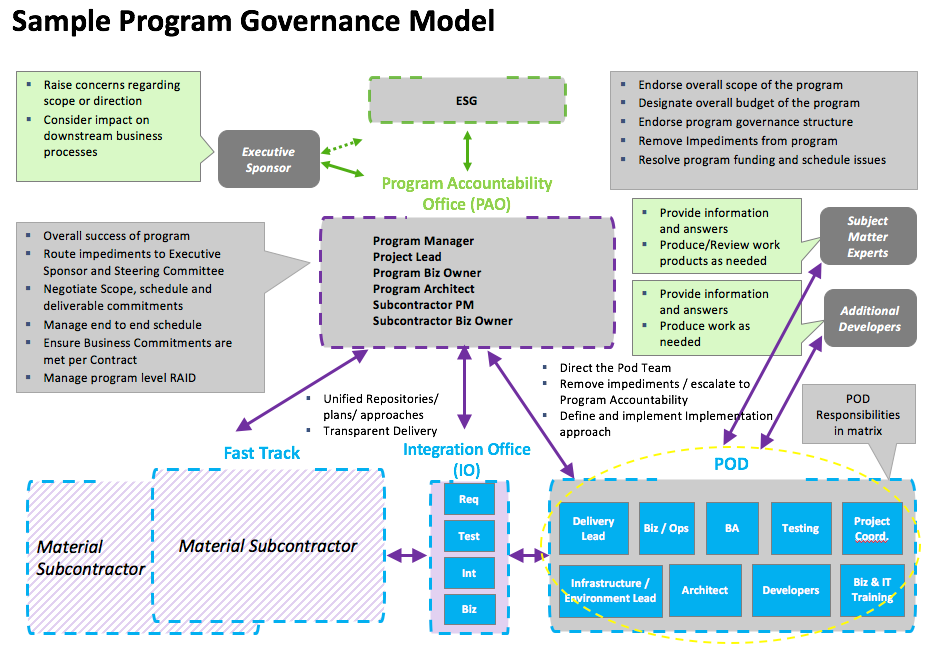Leveraging Pragmatic Agile for Government Programs
How Trexin’s Pragmatic approach applies the power of Agile methodology to meet the dynamic and challenging demands of government healthcare programs

Agile, or Agile project management, is a technique that was originally created for software development 15 years ago. It is a successful methodology, widely-used across multiple industries, that promotes incremental and iterative development and emphasizes collaboration and adaptability throughout a project. Agile has numerous implementations (Scrum, Lean, Extreme, Clear, kanban, etc.), but all adhere to four core values:
- Individuals and interactions are valued more than processes and tools
- Working software is valued more than comprehensive documentation
- Customer collaboration is valued more than contract negotiation
- Responding to change is valued more than following a plan
Pragmatic Agile is Trexin’s adaptation of the methodology beyond software development, to enable enterprise-wide project implementation and promote the kind of interdisciplinary and cross-organizational planning, and project management that today’s rapidly evolving health system demands. Trexin’s Pragmatic Agile approach optimizes both the inherent rationality and flexibility of Agile to enable innovative program implementation not just within IT, but across the business and operational units of organizations as well. It is ideally suited to the constantly changing nature of government program requirements and regulations and the ambitious, unpredictable timelines for public programs.
Pragmatic Agile is ideal for the highly complex deliverables and aggressive timelines of government programs
Because of the public nature of their development and the sheer number of interests with input into government programs, Medicare and Medicaid usually demand a high volume of complex deliverables with challenging compliance criteria and aggressive timelines. Morever, these challenges all too often result in requirements remaining in flux up to, during, and even beyond delivery. Agile is tailor-made for projects with very challenging deadlines because it allows the team to determine and commit to what can be accomplished in any two-week project period or “sprint” and then build incrementally on those deliverables, increasing speed with every successive sprint. Changes in requirements just become another part of the ongoing iterative, incremental process.
Agile deliberately focuses the team away from the overwhelming complexity of the entire project at once and toward only those deliverables that have been prioritized for the current sprint. The team conducts an exercise after each sprint dedicated to planning for the next one. That gives them the opportunity to move future work up or down in priority based on new information gained from the work they just completed, new management priorities, or new government agency deadlines or requirements.

Pragmatic Agile is ideal for organizations that are implementing healthcare programs pursuant to government contracts or public projects
The Agile project development framework is particularly well-suited to government contracts and public programs because it is specifically designed to adjust for and accommodate frequent changes in requirements, scope and timelines; all of which are inherent to government programs.
In today’s rapidly-evolving healthcare environment and given the transition to highly complex care management in Medicare and Medicaid programs, Pragmatic Agile methodology provides a proven, effective way for staff across the organization, from IT to operations to subcontractors. It enables them to navigate the complexity and adjust to incremental and large-scale change in a manner that is more predictable and productive.
Deploying Agile requires targeted investment in resources to set up and train personnel, and that investment will produce significant, ongoing improvements in efficiency and flexibility
Change is hard. People need to be willing to break current habits, develop new habits, and learn from those who have not only succeeded but learned from failures. And the enterprise needs to invest in rearranging their physical facilities to foster open collaboration and communication. In the end, however, what matters is delivery. Sustainable, continuous delivery over time is preferable to last-minute delivery through heroic effort. One Product Manager at a client where we used Agile to deliver their first product in four years, summed it up: “I never worked harder in my life…and I never want to go back.”
Q and A with Agile Experts
To explain how Pragmatic Agile can be successfully leveraged to implement and sustain government programs, I interviewed Trexin experts Glenn Kapetansky and Rick Hailey. Glenn Kapetansky is a Senior Principal in Trexin’s Healthcare Practice with more than 20 years of experience in executive management of complex systems and programs in industries ranging from healthcare to finance to consumer products. Glenn is also an expert in Agile methodology and project management. Rick Hailey leads the Agile practice as part of Trexin’s Solutions Delivery Capability. He has more than 25 Years of leadership experience building expert class delivery teams with his teams winning numerous industry awards. Rick is an expert in Agile frameworks and program delivery and a certified Scrum Master and Product Owner with over 20,000 hours of successful implementations across a diverse product base.
What are the main distinctions between Agile and older, more traditional development and implementation methodologies?
Rick Hailey: Agile is Expert-led, the “do-ers” (not the managers) lead the effort. It focuses on short-duration deliverables that quickly build productive teams, trust in the process, and momentum that increases speed as you go along. It accepts and, in fact, encourages changes in priorities based on new information. This is a major contrast with other project management methods that rely on strict adherence to a unified project plan that can leave people scrambling when priorities or timelines have to be shifted.
That said, within the context of planned 2-3 week increments or “sprints,” Agile enforces strict deadlines and requirements and allows you to focus resources quickly on those. The major components of success are empowering the people who have been there and done the work and removing barriers to their getting the job done. A Waterfall SDM approach doesn’t have that.
Glenn Kapetansky: I think of Agile in terms of the social memes of 2001, when the Agile Manifesto was written. In 2001, the management consulting books on our shelves touted “reengineering,” “management by objective,” and “360 evaluations.” The Manifesto authors were reacting to the hierarchical, rigid software development methodologies of the time in the same way that organizational development gurus were reacting to hierarchical, rigid organizations. Whether it’s software development or corporate management, it’s all about getting people motivated to get things done and rewarding them for it.
How did you adapt Agile from a software development environment to one of large-scale business program and operational implementation?
Glenn Kapetansky: My own clients helped me evolve my thinking. Agile helped my teams develop software quickly, only to stall trying to deploy their software into legacy production environments. Long before “DevOps” was a buzzword, one large-corporate client coined the phrase “winning the development war only to lose the deployment war,” and I never forgot it. Then, another large client came to us with a government program they won, which was really about setting up a whole business unit and only incidentally about IT systems. We added business, operations, training, and even policy and procedure experts to our Scrum teams, and it worked!
Rick Hailey: Producing processes and procedures and policies allow for the same rigor as does a technical solution. Adapting Agile to perform productively in that environment is simply redefining the stories with a different definition of done.
What are the most important things for someone who is new to Agile to know about the framework and methodology?
Glenn Kapetansky: A lightweight process Is not the same as no process; in fact, it requires more thinking and more personal discipline than a more prescriptive process. I remember one Business Lead who was delighted to “learn” that he controlled IT priorities. He started changing his mind every week until it dawned on him that he was also responsible for his Agile team producing exactly nothing, as it faithfully pivoted to follow his changing direction.
Rick Hailey: It does not have to be difficult; it is a common-sense approach to managing workflow. Keep your eye on getting to the definition of done for each story and avoid extra work during the sprint. Avoid scope creep during the sprint. Implement minimum shippable functionality and then build upon that incrementally.
Why is Agile so ideally suited for implementing government-sponsored programs and even more specifically for healthcare organizations?
Rick Hailey: Agile is inherently outcome-based, which is aligned very strongly with the healthcare transformation CMS is promoting in Medicare and Medicaid programs. In an Agile program implementation, for example, by the time the government agency readiness review occurs, the teams, or “pods,” have already worked through consistent reviews as one of the Agile project rituals, which makes them better-prepared. Agile accommodates the constantly evolving requirements of government programs, as well as changes in laws, deadlines, and leadership of government agencies.
Glenn Kapetansky: As mentioned above, requirements in government business are often late, conflicting, and changing. Agile is the only method that takes changing requirements as a given and works towards results from there. Healthcare.gov is a perfect example of waterfall simply being inappropriate for healthcare and government business problems.
What are the biggest challenges to transitioning from a traditional project management approach to an Agile implementation?
Rick Hailey: We’ve all experienced that old habits are hard to break. Agile teams are supported and trained to blow through the roadblocks of “old habits” in front of them and deliver outcomes. Getting people to understand that they have the authority to remove administrative barriers and that they are expected to do can be at first scary, but then empowering. People are making commitments to sprints for 2-3 week periods of time. Like plays in football, everyone on the team knows their roles in each of the plays. IT is a team approach to the commitments. Waterfall, on the other hand gives you a project manager to baby-sit you every day and tell you what to do. Agile empowers Team Members, again, the “doers,” to do what they need to do to deliver.
Glenn Kapetansky: Rick is exactly correct. Our human minds operate largely by habit and routine. Even when teams intellectually learn the new behaviors, it’s slower, harder, and when (not if) attention wanders, people will snap back to their old habits. When I was a musician, when I practiced, I forced myself to practice the right notes twice for every single mistake I made—once to negate the wrong note and once more to establish the new note in my head.
What should those who are starting their first Agile implementation expect?
Rick Hailey: There are three main roles in Agile: Product Owner, Scrum Master, and Team Member. Expectations are different for each. Product Owners should expect to define the definition of done. Scrum Masters should expect much less work than a traditional project manager in guiding the team and more work in removing impediments. Team members should expect to wear many hats to help solve problems. Everyone is accountable, and progress is measured in a regular and transparent way.
Glenn Kapetansky: Rick used a football metaphor above, so now I’ll use a soccer one: your first Agile implementation is like Pee Wee soccer, where everyone eagerly heads for the ball. So listen to your coach! Over time, you and your teammates will learn to “play your position,” while supporting theirs.
Can any organization utilize Agile to improve program development and implementation?
Rick Hailey: Any organization that is willing to accept disruption for a short time to learn its way around the framework and then expand it can utilize Agile to great benefit. After accepting short-term disruption and learning the framework, then you can watch Agile significantly improve your ability to implement programs and the speed at which you implement.
Glenn Kapetansky: As long as the organization’s culture is aligned with Agile’s Four Core Values above, Agile will produce better results than other methods
Is Agile more resource-intensive than traditional approaches? How is it cost effective?
Rick Hailey: Agile requires the same resource intensity as traditional approaches to implementing programs, but the people who have to wear more hats are also more empowered and more accountable. Adhering to Agile methodology ensures that you don’t waste time on low-priority functions and features. Agile allows you to identify, prioritize, and then focus resources on the most critical priorities first and prevent your team from getting distracted by challenging, but low-priority items.
Glenn Kapetansky: Agile often appears to be more resource intensive because, during the initial change period, it needs to not only deliver but also teach/coach/change the organization around it. In steady state, it actually represents a cost savings, although that may well be the due to the fresh look at old processes and elimination of built-up inefficiencies.
Conclusion
The current era of healthcare transformation, with its seismic shift to value-based care, data-driven decision making and delivery, consumer-directed care, and significant cost control, demands a commitment to new ways of operating across the system. Agile is a proven and powerful method of enabling that transformation in a positive and efficient way. If your organization has been struggling to meet the demands of a new government program or is questioning how to deliver on an existing government contract, utilizing Pragmatic Agile could be the perfect fit to get you the outcomes you need and the organizational capacity to continually improve upon them.
For more information
THE AGILE MANAGER – As Quickly as Possible, but no Faster





